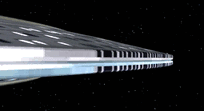 |
|
 |
|
|
|
|
|
| Resource Profile |
| resource type |
|
| Technology |
| resource series |
| All Series |
|
Sensors can be seperated into 3 main categories: long-range, lateral, and navigational.
Long-range sensor systems: Long-range sensor systems are located directly behind the main deflector dish in most Federation vessels and include EM scanners, a telescope and a thermal imaging array. It is designed to scan ahead of the starhip to detect the presence of objects or unusual phenomena. The sensor array consists of high power subspace frequency sensors that are able to retrieve information at speeds faster than light. Aboard a Galaxy-class ship, the normal operating range at high resolution is five light years, although this range can be increased to 17 light year with significant loss of quality of data. The sensors scan in the direction of flight with a primary purpose to detect and protect against pieces of interstellar debris that could be disastrous if impacted against even at sublight speeds.
Lateral sensors: Lateral sensors can be compared to the human skin. Like the skin, the hull of a starship is instantly aware of changes to its enviroment due to a series of lateral sensors positioned all around the hull. Each array consits of a rack of individual sensors instrument pallets; there are 144 of these, distributed on the primary and secondary hull lateral arrays, both fore and aft. In all, there are 284 pallet positions, and special designation pallets can be installed for specific missions. Modular instrument devices have been designed to be able to be quickly replaced if damaged. Larger devices in modules are positioned near personnel airlocks to provide easy access for extravehicular replacement. Smaller instrument devices are accessed through service ports inside the ship (typical: Galaxy-class starship).
Navigational Sensors: Sensors are found on saucer and engineering hulls of a starship. They feed raw data into the ship navigational processing computers continuously. This data is then converted simultaniously into readable information on the ship's position and velocity. Two different types of navigational sensors are employed. Long-range sensors are used when travelling through normal space, often at warp speeds; however, when a ship is within a star system or orbiting a planet, shor trange sensors provide more than just navigational information. In Galaxy-class vessels, there are a total of 350 navigational sensor assemblies that are isolated from the general sensor arrays to provide a fast and direct link to the computer processing units and to eliminate any chance of crosslinks. Navigational sensors allow starships to safely navigate around planets and other bodies within star systems. |
 Galaxy Galaxy-Class Sensor Array |
| Resource By: | |
| Posted: |
2003.02.20 |
|
|
|
|
|
|
|
 |
. |
 |
|


|





